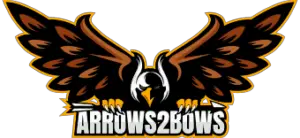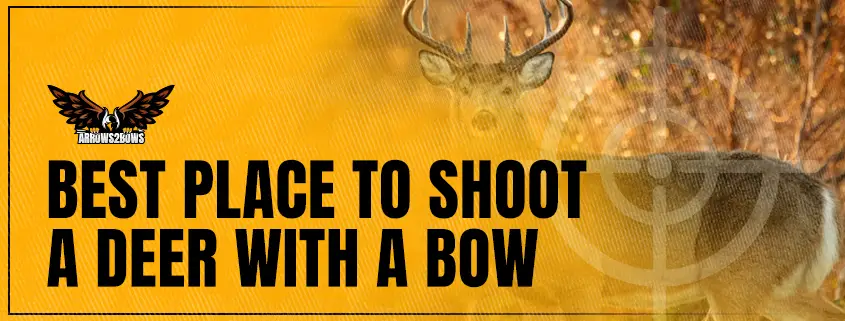The Best Place to Shoot a Deer With a Bow
Proper shot placement is a key element to successful bowhunting. You can spend the off-season putting arrows through bullseyes to improve shot accuracy, but if you don’t know where to aim, you’re probably going to go home empty-handed.
Ultimately, your goal should be a quick, humane kill. Where to aim to achieve that goal largely depends on geometry. The position of the deer and the hunter must be taken into account for every shot opportunity.
There are also some shots a bowhunter should never take, no matter how tempting.
Let’s take a closer look at where to shoot, when to shoot, and when to just let a deer walk away.
Understanding Whitetail Anatomy
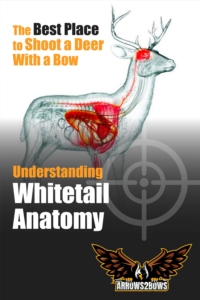
Having a clear understanding of whitetail anatomy will help you understand where you need to shoot. For a quick and ethical kill, the goal is to maximize trauma to the heart and lungs. These essential organs are often referred to as “the vitals.”
The lungs are a deer’s largest organs. They sit directly inside the chest behind the front shoulder and extend several inches to the rear. The heart is located below them, nestled between the two lungs.
When a broadhead slices through the vitals, it causes significant blood loss and sometimes suffocation. While that may sound brutal, it makes death come quickly, which should always be the goal when harvesting an animal.
Once you understand the position of a deer’s major organs, you can visualize the path of your arrow through the area. Where to aim changes depending on the deer’s position, relative to your arrow. The angle at which a shot moves through the animal can cause a shot to miss important organs, even if you hit your mark perfectly.
The Broadside Shot
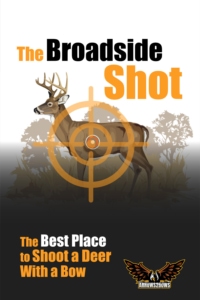
When a deer is positioned perpendicular to the hunter, it is referred to as a broadside shot. The broadside shot is the stuff hunting dreams are made of, because the vitals are right there in front of you with nothing but a few fragile ribs in the way.
A broadside presentation also offers the bowhunter the largest possible target. That means that even if your arrow misses its mark by a thin margin, it still has a high probability of piercing a vital organ.
Ideally, you want to aim for the point where the heart and lungs meet. This spot provides some forgiveness, allowing you to still hit the lungs if you miss your mark by a few inches. If your broadhead pierces a few inches behind your spot, you’ll still clip the liver and the rear part of the lung. While not the absolute best shot, it’s still likely to result in a quick kill.
Finding the Pocket
A simple trick for finding the proper spot to aim at a broadside deer is to visually divide the deer’s chest into three equal, horizontal sections. Remember the location of the imaginary line between the bottom and middle sections. Next, draw a vertical line up from the spot where the deer’s front leg meets the body.
Where these two imaginary lines cross is sometimes referred to as “the pocket.” A broadhead in or near the “pocket” almost guarantees a quick, clean kill, at least on a deer facing broadside.
The Quartering Away Shot
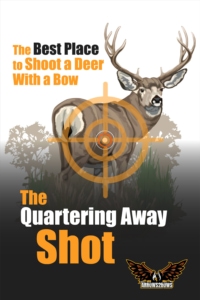
While a broadside shot is a good one, most bowhunters prefer the quartering away shot. Although this position does not offer quite the same target area, a well-placed arrow will pass through more vital tissue with this presentation, driving through the liver, lungs, and heart.
A quartering away shot also moves the deer’s tough shoulder blade out of the way, allowing a clean, unhindered path to the vitals.
Instead of focusing on where you want your arrow to enter the body, aiming for the spot you want your arrow to exit will help ensure maximum internal damage. To do this, visualize the deer’s opposite shoulder, the one facing away from you. Place your pin in line with the opposite leg, approximately one third of the way from the bottom of the body.
This method of aiming for the opposite side will have your arrow striking closer to the middle of the deer’s body rather than the pocket behind the front shoulder. Aiming for the pocket at this angle will cause your arrow to strike too far forward, just clipping the front of the lungs or missing the vitals altogether.
Avoid taking a shot on a deer quartering at a sharp angle. If the angle is too sharp, your broadhead may only hit one lung. Deer can run a surprisingly long way with a single lung injury. This reduces your chances of recovery and can cause the animal unnecessary pain and suffering.
How do you know if the angle is too sharp? First, imagine the face of a clock where you are standing where the six would be located. (A broadside shot would have the deer facing straight across, with its nose pointing at the three or nine on the imaginary clock face.) If the deer’s nose is pointing toward the two or ten, take the shot. However, if the deer’s nose is any closer to the twelve, hold your shot until the deer offers you a better angle.
The Quartering Toward Shot

When a deer is slightly facing you at an angle, it is called quartering toward. This angled presentation is common when a deer is called in with a grunt tube, doe call, or rattling antlers.
Most bowhunters will pass on attempting a quartering toward shot. When a deer is in this position, the skeletal structure places the leg and shoulder bones, as well as some pretty thick muscle, right in the way of your arrow. These hard obstacles prevent a clear path to the deer’s vitals and can keep your arrow from penetrating deeply enough to wound the heart and lungs.
If the deer presents at only a slight angle, making it mostly broadside, an ethical shot may be possible. However, the more the deer is angled to face you, the smaller the “kill zone” becomes. If you question the shot, hold it until the deer gives you a better angle.
The Straight-Away Shot
It may be tempting to lose an arrow on a big buck that isn’t in the best position, especially if he’s walking away from you. You may be worried that a shot at that iconic white tail will be the only shot you get. Don’t take it.
Although it’s possible to make a fatal shot in the rear, it isn’t easy and it isn’t guaranteed. The femoral artery is located just along the inside of a deer’s hind legs. Even a tiny nick to this artery will cause tremendous blood loss. However, the target is tiny, making it difficult to hit by even the most skilled archer.
A straight-away shot (sometimes called the Texas heart shot) is more likely to cripple or seriously injure a deer, causing a slow and painful death. If a monster buck is sauntering away from you, the responsible thing to do is just watch him go.

The Straight-On Shot
When a deer is facing you straight on, the path to the vital organs is blocked by hard bone and thick tissue. You are more likely to injure a deer with a head-on shot than you are to kill it.
Although it may be tempting to get off a quick shot before you are seen or heard, it is best to wait for the deer to assume a more favorable position. Besides, a deer facing you is more likely to spot the movement of you drawing your bow.
The Key to Making Shots from a Treestand
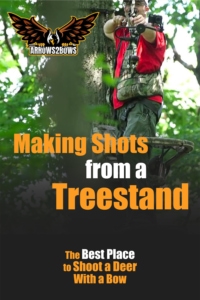
A large number of bowhunters choose to hunt deer, especially whitetails, from a treestand. The elevated position provided by a treestand helps keep the hunter out of a deer’s direct line of sight. It also helps the hunter spot deer moving through the woods.
However, shooting from a treestand significantly changes the path of your arrow as it travels to and through your target. When shooting from an elevated platform, you won’t be aiming at the same point on the body as you would when shooting from ground level.
The exact spot to place your arrow depends largely on the height of your stand and the distance to the deer. However, most shot opportunities are going to be brief and fill you full of adrenaline. You aren’t going to have the opportunity to pull out your protractor and slide rule to figure out the perfect point to place your arrow.
As a general rule, you should aim higher than you would if you were shooting from the ground. Visualize the path of your arrow through the deer’s body, and aim so that the arrow passes through the center of the body, damaging the heart and lungs. Many seasoned bowhunters suggest aiming for your intended exit point on the opposite side of the body to ensure the arrow path is perfect.
You also need to be careful with those close-up shots when you’re hunting from a treestand. Straight down shots are tempting, because it feels like you’re standing right on top of the deer. However, a straight down shot is highly likely to end with a fatally wounded, yet unrecoverable, animal. This type of shot typically results in a single-lung hit. This deflates the lung, which ultimately kills the deer, but only after several hours of agony.
Instead of risking a shot on a deer directly under your stand, be patient. Eventually, the animal will wander from that spot and hopefully present a more favorable angle for an ethical kill.

Making Uphill and Downhill Shots
Even if you prefer not to hunt from a treestand, the ground is rarely completely flat. This means you’ll eventually have to make some uphill or downhill shots.
Just like when you hunt from a treestand, you need to adjust shot placement when hunting uneven terrain. Again, you’ll need to visualize the flight path of your arrow and adjust your aim to ensure it passes through the vitals. Steep angles, whether up or down, can end in a one-lung shot. It is best to avoid shooting deer at severe angles.
Making a Pass-Through Shot
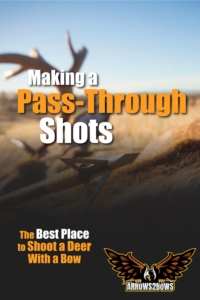
To help ensure a quick, humane kill, you want your arrow to pass completely through the deer’s body and come out on the other side. There are two good reasons you want a pass-through shot.
First, a broadhead that passes all the way through the body produces maximum internal damage. The second reason you want a pass-through shot is that it creates two wounds – an entrance wound and an exit wound. Although these are technically part of the same wound, the two holes will produce a more visible blood trail. The more blood spilled on the ground, the easier it is to track the deer, and the higher your chances of recovery.
To achieve a pass-through shot, you need to be equipped for maximum penetration. Sharp broadheads will help. Be sure to sharpen your broadheads before you use them in the field. Broadheads do not typically come out of the package sharp enough for hunting.
You can also increase penetration by beefing up your arrows. It may seem counterintuitive, but heavier arrows will drive deeper. Adding a little more weight to the leading end of your arrow shaft (50 to 75 grains depending on your personal set-up) will boost your front-of-center (FOC) weight and increase target penetration.
Some other strategies for ensuring proper arrow penetration are dialing up your bow’s draw weight and only shooting targets within close range.
Aiming Low and Jumping the String

Some bowhunters like to aim slightly lower than where they want their arrow to hit. Aiming low is used as a safeguard in case the deer “jumps the string.” A deer’s natural reflex is to drop suddenly when he hears an alarming sound. This quick crouch loads a deer’s powerful back legs to propel him to safety. This reflex is called “jumping the string.”
When a deer jumps the string, it usually causes the arrow to hit above your intended target. Sometimes a deer can drop so quickly the arrow flies completely over the deer’s back, missing the animal entirely.
By aiming slightly lower than you want your arrow to strike, you increase your chances of scoring a clean hit if the deer drops. Instead of aiming for the pocket, aim slightly lower, targeting the center of the heart.
Not all deer jump the string. It is much more common in whitetails than for mule deer or elk. A deer may act like nothing happened. However, you can’t predict which deer will jump and which will stay put. By aiming for the heart, you can still achieve a killing shot whether the deer jumps the string or not.
Accuracy is key if you choose to aim for the heart, especially if the deer remains stationary. The hard leg bone could come into play and deflect your arrow. If possible, wait for the deer to step forward with its front leg, especially if the deer is presenting broadside. This will place the shoulder blade and leg bone out of the way, providing a clear shot to the vitals.
Making the Shot
When you are hunting deer with a bow, making the first shot a good one is imperative. If your first shot is even slightly off, you probably aren’t going to get a second chance.
Before releasing your arrow, make sure you have a clear shot. Leaves, branches, and even grass between you and your target can deflect the arrow and cause a clear miss or a bad shot.
Patience can be tough, especially if you’ve got a monster buck in your sights. However, you want to wait until the deer is clear of any obstacles and presents a favorable shot angle.
Be sure to control your breathing. Not only will it help keep you calm, it is also necessary for good shooting form. When your adrenaline is pumping, you may unconsciously hold your breath or your breathing rate may increase. Practice slowing your breath, especially after you draw your bow. The best time to release the arrow is after a calm exhale.
Practicing for Bow Season
Practice is the fundamental to consistently hitting where you aim. However, you want your practice to be effective.
Shooting your bow is the best way to become familiar with your archery equipment and gain proficiency. While you can start by shooting arrows at bulls-eye targets, bowhunters will want to take their practice a step further.
A life-size 3D deer target makes your practice more realistic. Not only will you get practice hitting where you aim, a 3D target also helps you become familiar with the location of a deer’s vital organs. Some targets even feature a cutaway section that reveals the shapes and locations of the heart, lungs, and liver. Others have a more basic outline of the vital area.
If you practice with a 3D target, be aware that a hit to the “ten ring” may not be the best option depending on the angle. (“Ten ring” is a term for the vital area outline on a 3D target. Its origins are in competitive archery where an arrow in this area scores ten points.)
If you plan to hunt from a treestand, put in some shooting practice from an elevated position. This will help you get accustomed to shot placement (as well as drawing and aiming your bow at a downward angle) before the season starts.
The Best Compound Bow for Whitetails
Finding the perfect compound bow for deer hunting depends on several factors, including your draw length, strength, and personal preference. Ultimately, you want a bow that is quiet, easy to shoot, and works like an extension of your body. That means a bow that is perfect for one hunter may not work for another.
However, our top pick for bowhunting is the Obsession HB33. This rig has a solid back wall and a custom grip for proper hand alignment. It also produces some pretty impressive arrow speeds.
The Obsession HB33 features a hybrid cam system with inter-rotating modules that make it super easy to customize draw length. Fast, quiet, accurate, and fun to shoot, we highly recommend you give the Obsession HB33 a shot next deer season.
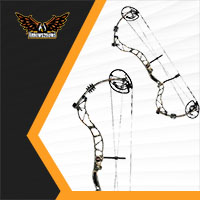
Final Thoughts
When it comes to deer hunting, especially when a bow is your weapon of choice, knowing where to place your shot is critical. However, knowing where to hit a deer and actually sending a broadhead through that spot are two separate skills. We can’t stress the importance of practicing both accuracy and shot placement well before the opening day of the archery season.
Bowhunting is a lot like a complicated math problem where the variables are constantly changing. In the woods, these variables can shift in an instant, often ruining an otherwise perfectly good shot. Not only should you be aware of angles and flight path, you should also watch for branches and leaves that could deflect an arrow on its way to your target.
Bowhunters have to constantly assess and adapt. If you question any aspect of a shot, it is best to wait for a better opportunity, even if it means you don’t get a shot on that big trophy buck.
